Google Ads is arguably one of the most misunderstood platforms for paid advertising. Many business owners promote their wares with sponsored posts on social media sites like Facebook, but underutilize Google Ads, despite the unique opportunity it offers to advertise their products and services directly to people actively searching for them.
Google puts a large breadth of advertising tools at your fingertips. It also gives you access to users of the world’s two largest search engines—Google and YouTube, respectively—and a network of millions of websites to advertise on.
Unfortunately, Google Ads has a complicated interface and a steep learning curve. If you don’t know what you’re doing, you can end up targeting too broad of an audience and spending money without turning a profit.
But everyone has to start somewhere, and whether you plan on managing your own Google advertising or outsourcing it to an expert, it’s best to begin by learning the necessary terminology and knowing not only the campaign and ad types available to you, but what you can realistically expect from them. That way, you’ll understand exactly what the platform can do for you.
Table of contents
- Why use the Google Ads platform?
- Google advertising terms and concepts
- How to use this Google advertising playbook
- The Google Ads playbook: 13 campaign types you can run
- Budgeting: "Always-on" vs. "testing" campaigns
- How to hire help
- Final thoughts
Why use the Google Ads platform?
Google Ads has a lot in common with many other paid advertising platforms. With it, you can:
- Set flexible budgets as low as $5.
- Pay per click (in most cases), so you’re only charged when someone visits your site.
- Turn spending on or off at will.
- Get fast, measurable feedback on campaign performance.
- Target a specific audience based on specific behaviors, how they’ve interacted with your site or brand before (from visiting a certain page to abandoning their cart), demographics, interests, and other traits.
- Achieve tremendous scale with your campaigns.
But what makes Google Ads uniquely attractive is its ability to reach consumers in three distinct ways, the first of which is Google’s bread and butter and what you can’t get on platforms like Facebook: Search ads.
1. Search ads
Consumers generally use search engines—unlike social media—with a specific intent in mind: to search for answers, get solutions to their problems, or find specific products or services. This makes Google a powerful marketing channel for a variety of businesses.
You can inform how you advertise on Google based on the average volume of monthly searches for a given query, the estimated cost you would pay per click, and other data Google makes readily available. You can run search ads that promote your products and services directly in the search results of a specific query and even narrow your targeting to users in a certain geographical area.
Say you’re selling plant-based protein powder. More than 200,000 people search for “protein powder” on Google every month, but there are far fewer searches for “vegan protein powder.” Google will let you bid (more on this below) to advertise your brand on both of these phrases individually, but the more specific search term likely will convert better because it’s more relevant to your product.
You can create text ads, which display in search results marked with the word “Ad” in a small box, or Google Shopping ads, which surface key purchasing information, such as product photos, prices, and ratings—something that makes them perfect for many ecommerce brands. You can see both text and Shopping ads in action below.
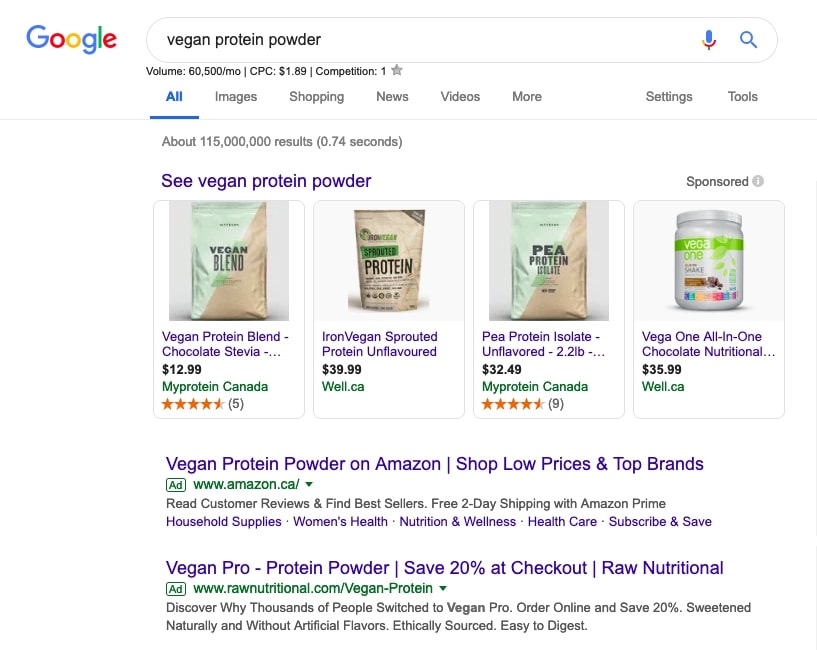
2. Google Display Network
You can also advertise your products or services to potential customers through the Google Display Network.
Display advertising gives you the option to reach people outside of Google’s search engine results, through text, image, and video banner displays that appear as users browse the web, use apps, or watch videos.
While many advertisers turn to Facebook for their display advertising, Google is also a viable option.
The Google Display Network reaches 90% of all internet users around the world and consists of ad space on more than 2 million sites and 650,000 apps. Visit any news site and you’re likely to see Google display ads at the top, in the sidebar, or even throughout the content itself.
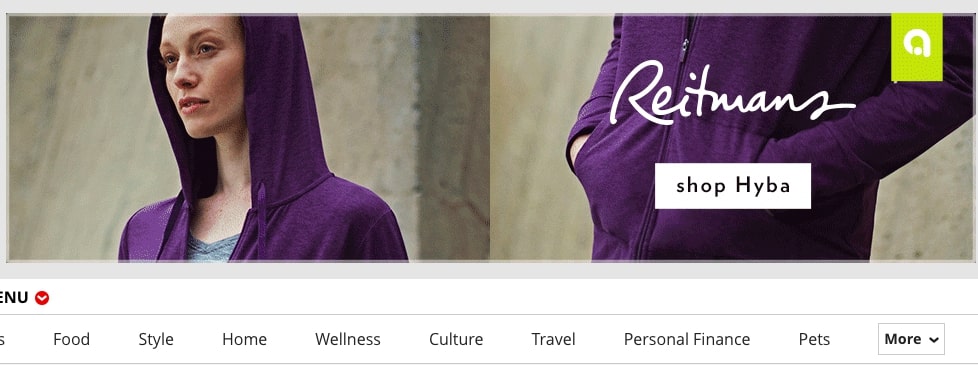
3. YouTube ads
The Google Ads platform also lets you advertise on YouTube, which is owned by Google. Technically, YouTube is just one site in the Google Display Network but, measured on its own, it is the third most-visited site on the web, after Google and Facebook. Users watch more than one billion hours of YouTube videos a day. That makes for a lot of opportunities to engage potential customers.
You’re probably familiar with the pre-roll ads that play before YouTube videos, but there are also banner and overlay options.
As you can see, Google offers a variety of ad types. But before you choose between text, image, or video, you need to understand where your ads will be shown and who will see them.

How the Google Ads auction works
Many of the campaign types available through Google Ads operate on an auction system. Advertisers compete for a position or “rank” on the search engine results pages by bidding (usually) on clicks.
The amount you bid and how you set up your keywords will determine your placement in relation to other bidders. However, the highest bidder doesn’t necessarily win the top spot; relevancy is also a determining factor.
Google wants to show ads that are useful and relevant to its users, and you want to advertise to relevant users who are searching for your business or terms related to what you’re selling. So Google assigns an Ad Rank based on various factors, such as the relevance of your ad copy and ad format to the keywords you’re buying, the webpage you’re sending visitors to, and more.
As an advertiser, the more relevant your business is to the terms you’re buying, and the more relevant your ad messaging is to users searching for those terms and the page you’re sending them to, the cheaper it will be for you to rank for that traffic.
Before you dive headfirst into the world of Google Ads—or hire a professional to manage your marketing on the platform—there are some key concepts and campaign types you’ll need to understand.
Google Ads terms and concepts
Paid marketing—Google Ads in particular—comes with its own vocabulary of terms and concepts. Here’s a glossary you can reference if you encounter a term you’re unsure of:
Paid marketing terms to learn
- Impressions: The number of times an ad is viewed.
- Cost: The amount of money a campaign spends on paid advertising.
- Clicks: The number of times your ad was clicked on by a user.
- Conversion: The specific goal you are tracking (a sale, a view of a high-value page, an email sign up, etc.).
- CPM (cost per thousand impressions): The ad buyer’s cost to have their ad seen 1,000 times.
- CPC (cost per click): The ad buyer’s cost per click. CPC can be as low as a few cents or as high as a few hundred dollars, depending on competition, your industry, and audience relevance.
- Cost per conversion: The ad buyer’s cost per purchase, order, acquired customer, or another conversion goal you’ve set.
- CTR (click-through rate): The percentage of users who clicked on your ad out of the total number of impressions it received. Your click-through rate is the most significant signal of relevancy in Google’s search auctions.
- Conversion rate: The number of conversions divided by the number of clicks, expressed as a percentage.
- Budget: The total amount of money allocated to an ad campaign.
- Revenue: The total value, in dollars, generated by an ad.
- Profit: The total value, in dollars, generated by an ad after subtracting expenses, such as advertising costs and cost of goods.
- ROAS (return on ad spend): Revenue generated from an ad divided by the advertising cost to show the return on that ad. For example, $5 made for every $1 spent yields a ROAS of 5:1.
- AOV(average order value): The average dollar amount a customer spends on a site. AOV is calculated by dividing the total revenue by the number of orders.
- CLV (customer lifetime value): The predicted total value of a single customer (sometimes called LTV) for the entirety of their relationship with a company, including future purchases.
Terms and concepts used in Google Ads
- Campaign: A campaign contains a single advertising objective, such as traffic or conversions, for one or more ad groups. Budgeting is done at the campaign level and if you expect certain things within a campaign will perform differently (better or worse) that’s a good indication it should be a separate campaign.
- Ad group: An ad group contains one or more ads and your targeting. A good ad group set up has a unique set of ad messages that directly match your targeting.
- Ad: The creative ( text, image, video, etc.) that users will see.
- Keyword: The phrase or word(s) a user enters into the search engine.
- Keyword match type: Keyword match type involves controlling how broad or exact the chosen keywords (synonyms, related searches, etc.) must be to trigger an ad.
- Negative keywords: If you want to prevent your ad from being triggered by a certain word or phrase, you would add it to your negative keywords list. This helps you exclude similar but irrelevant keywords (e.g. “apple cider” for Apple the brand).
- Quality score: The relevancy of an ad to the search term or audience being targeted. Generally, the higher the quality score, the lower the cost per click and the better the ad position.
How to use this Google advertising playbook
We’ll break down everything you need to know to help you understand what goals and realistic expectations you should have from each type of campaign available through Google. This will help you determine the best campaign for your circumstances.
Keep in mind there will always be trade-offs and other dependances to consider. For example, certain campaign types sacrifice segmentation—bundling various audiences together, making it hard to isolate specific high-performing groups—but will be easier to set up yourself or through an app or integration with Shopify.
Other campaign types might be harder to execute successfully, requiring more manual set up and ongoing optimization, especially if certain audiences or keywords are highly competitive. These campaigns will require more technical expertise, time, and money.
For this reason, any ranges or estimates given here are meant to serve as guidelines. Your actual cost per click or expected return will depend on many variables, such as how well your website converts, your average order value, and how much scale there is for a certain type of keyword or audience.
We’ll outline each campaign type according to the following information:
- Goal: What does this campaign type accomplish and how? Should it drive sales by focusing on past visitors to your site? Should it sell to existing customers or acquire new ones? Should it raise awareness among a certain audience segment?
- Relevance to audience: Your business and products may or may not be relevant to a certain search term or audience. Generally, the more relevant your product or service is to a targeting method, the lower your cost and the higher your likelihood of getting traffic to your site and making sales.
- Estimated cost per click: This is a general estimate of how much you will be spending for each prospective shopper and will vary depending on your industry. Remember that you will often be paying for every click, and ongoing optimization is necessary to maximize the value of your spend.
- KPIs (key performance indicators): What measurable values should you use to set goals for this campaign and measure its performance? We all want our campaigns to generate sales, but you can expect most visitors to your store won’t convert the first time they visit. That’s why KPIs like traffic and impressions are more important for campaigns focused on raising awareness and creating consideration versus direct sales and ROAS.
- ROAS Expectations: What kind of return on ad spend should you realistically expect from a campaign relative to other campaign types? This will be expressed as a range (e.g. 0:1 to 5:1) that is meant only as a guideline to help you prioritize tactics. There are many variables that will affect your actual ROAS.
- Scalability: Some campaigns may target users looking specifically for your branded products, or users who have already visited your site. Other campaigns target users based on their general interests or search history for a specific category of products. Each type of campaign will have a different ceiling or "scale" (i.e. the extent to which you can spend more to get more from the campaign).
- Recommended for: When does this tactic make sense and for what businesses? We’ll try to make recommendations based on different types of merchants, but use the above criteria to make the best call for your unique business.
- Ease of implementation: How easy or difficult a campaign will be to undertake, based on a variety of factors. Some campaign types are relatively easy to set up, while others require more expertise and ongoing management.
View these guidelines in relation to your goals and who you are targeting. For example, if your goal is new customer growth, you may be willing to break even on your campaign, especially if your business is in a position to generate repeat purchases from customers.
Not all businesses will be able to take advantage of all campaign types, and some of the more competitive campaigns often require a lot of human capital and time to manage. They can also be expensive, especially in the beginning.
Note: Since Bing and Yahoo! share similar features with Google, many of the campaign types below can also be run on those platforms.
The Google Ads playbook: 13 campaign types
1. Branded search

- Goal: Capturing searchers actively looking for your brand by name.
- Relevance to audience: High. (They’re searching for you.)
- Estimated cost per click: Low (~$0.25 to $3.00).
- ROAS Expectations: High (3:1 to 30:1). These searchers are looking specifically for your brand.
- KPIs: Profitability, number of orders.
- Scalability: This will depend on how established your brand is. It also will depend on how many people search for you, which can be driven up by other marketing efforts that increase brand awareness.
- Recommended for: All businesses, regardless of size and industry, will likely make sales when there is search intent for their specific brand. Prioritize this campaign if resources permit.
Branded keywords contain the exact names of a brand or product. “Apple phone” or “iPhone,” for example, are branded keywords for Apple.
You might not think to bid on your own brand name, especially if your site already appears organically at the top of search results, but doing so lets you promote specific information (using Google’s ad extensions) and set the exact page where you want people to land. It also protects you from competitors who might bid on your name or other branded keywords.
CPCs for branded search generally will be lower than for any other search campaign, since your URL and your ads will be highly relevant to users who search for you. At the same time, be wary of your ad appearing for similar but irrelevant keywords. In the example of Apple advertising iPhones, you would exclude keywords such as “apple picking” or “apple cider,” or even “how to update my Apple iPhone” and narrow your targeting using the appropriate keyword match types and negative keywords.
Since your ceiling for sales from branded search depends on how many people are actually looking for you, branded search campaigns can complement brand awareness campaigns. A pop-up shop or a viral Facebook video, for example, can translate into more searches for your brand name.
Ease of implementation: This type of campaign can be hard to implement if you’re not familiar with search engine marketing. Agency or in-house resources may be required. However, branded search isn’t that labor-intensive to manage, so make this a priority if you can.
2. Non-branded search (generic)
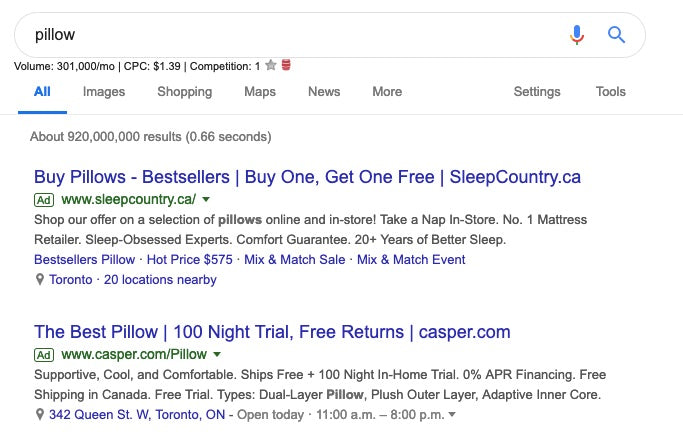
- Goal: Generating qualified intent-based traffic, and possibly new customers, by advertising to people who may buy your products but aren’t necessarily familiar with your brand.
- Relevance to audience: Low to medium.
- Estimated cost per click: Medium to High ~($1 to $20).
- ROAS Expectations: Medium (0:1 to 3:1, depending on competition, product/market fit, etc.).
- KPIs: New customer acquisition, revenue, traffic, number of orders.
- Scalability: Potentially large, depending on search volume from users and the type of terms.
- Recommended for: Everyone, but don’t prioritize this method before some of the more profitable campaigns on this list. For brands looking at growing top-line revenue and new customer acquisition, however, generic non-branded search should be a top priority.
Non-branded search campaigns, like the name implies, target keyword phrases that don’t include your brand or products by name. As such, your costs are likely going to be higher, since your relevance to users is lower, especially for more generic keywords (for example, “buy pillow” vs. “organic goose feather pillow in downtown Toronto”).
The goal of this campaign is driving new visitors and new customers to your site as efficiently as possible. But these campaigns can also have a positive ROAS for advertisers and a massive amount of potential scale.
Keep in mind that the true value of a customer is not their initial purchase but their lifetime of purchases from your brand.
Ease of implementation: As with all search campaign types, this one can be difficult. These campaigns require a lot of human resources to manage and test your creative and landing pages, plus a lot of money to drive results. It’s best to hire help to ensure these campaigns are managed correctly.
3. Non-branded search (niche)

- Goal: Acquiring new customers from niche audiences that match up with your niche products.
- Relevance to audience: Medium to high. (The more niche the audience and the better your product addresses that niche, the more relevant you will be to your audience.)
- Estimated cost per click: Medium to High ($1 to $20, depending on the competition and value of customers/orders to other advertisers.)
- ROAS Expectations: Medium (0:1 to 5:1).
- KPIs: New customer acquisition, revenue, traffic, number of orders.
- Scalability: This will depend on how many users search for these terms, which have naturally smaller audiences, especially compared to wider non-branded searches without these niche modifiers.
- Recommended for: Brands with a niche product or that are targeting a niche market within a non-branded product category, such as “vegan deodorant” or “used NFL game memorabilia.”
Niche non-branded search campaigns tend to involve less competition than generic non-branded ones. That’s because they’re more specific and, as a result, make you more relevant to the searcher’s intent if your products match what they’re looking for.
If your business and products are a fit for niche marketing, then this campaign type is worth exploring. Niche marketing, even outside of the context of Google Ads, gives brands a much easier time of getting traffic and, potentially, a positive ROI, because it offers a specific audience that’s easier to identify and focus on.
Niche non-branded search often is lumped together with generic non-branded search. But, for the reasons given above, it makes sense to segment this traffic in its own campaign and discuss it separately.
If you sell third-party products, you can also apply this campaign type by bidding on the specific branded keywords associated with them. When buying these keywords, you can even use these brand names in your ad creative as long as you link directly to a landing page that has those products visible.
Ease of implementation: Similar to other search campaigns, this campaign type isn’t easy to undertake and will require appropriate resources to set up and maintain. If you don’t understand keyword match types and how to build and optimize search campaigns, ads, and landing pages, we would recommend hiring an expert who does (more on that later).
4. Competitor search

- Goal: Acquiring new customers who might not know your brand or product by getting your brand in front of shoppers searching for your competitors.
- Relevance to audience: Low. (Users are searching for a specific competitor, not your brand.)
- Estimated cost per click: Medium to High (~$1 to $20).
- ROAS Expectations: Medium (0:1 to 3:1, depending on the competition and whether your competitors, or their competitors, are bidding on the same branded keywords).
- KPIs: Traffic, new customers, number of orders, ROI.
- Scalability: This will depend on how big your competitor’s brand is, how many users search for them, and other campaign efforts that drive awareness for them.
- Recommended for: Merchants already running profitable campaigns and interested in new customer acquisition. Also, merchants with a high LTV or who are actively testing different customer acquisition campaigns.
A competitor search campaign essentially is a branded search campaign in reverse. Instead of bidding on your own brand’s name and products, you bid on searches for your competitors’ branded keywords.
Stealing traffic from your largest direct competitors’ keywords sounds like a smart strategy, but it can also be a relatively expensive one because, in this case, you, a competing brand, aren’t the most relevant thing searchers want to see.
Typically, this strategy is employed by brands that can justify the higher costs of acquiring a new customer who might have a relatively higher average order value or lifetime value. Otherwise, you may experience little success with this strategy.
If a brand isn’t buying its own traffic or doesn’t have a lot of brand loyalty among its customers, and if your product is an equal or better alternative, this could actually be a very profitable campaign for you.
(Part of the reason we highly recommend buying your own branded terms is to prevent this type of disruption from a competitor.)
Note: You shouldn't use dynamic keyword insertion in ads when buying your competitor's branded keywords, nor can you use their name in your ads if you don't sell their product on the page you drive traffic to.
Ease of implementation: As with all search campaigns, this one is not easy to do and could be very expensive. You would want resources dedicated to managing this.
5. Google Shopping (branded)

- Goal: Capturing searchers who are specifically shopping for your products/product categories using your branded keywords.
- Relevance to audience: High. (They’re searching for you.)
- Estimated cost per click: Low (~$0.25 to $3.00).
- ROAS Expectations: High (3:1 to 30:1).
- KPIs: ROAS, number of orders.
- Scalability: This depends on how many users search for your brand and branded products.
- Recommended for: Companies selling physical products that have already invested in brand awareness and those who feel comfortable tweaking within Google Ads to set up this type of campaign.
Google Shopping campaigns generally offer a great user experience for shoppers: a user searches specifically for a product and is shown images, prices, and reviews of items Google thinks are relevant. If shoppers click the ad, they go directly to that product page.
In terms of new customer acquisition as an ecommerce business, this is at the top of your list of campaigns to try.
Users who specifically search for your brand are more likely to convert, so if you’re able to set up branded Shopping as a separate campaign, you can maximize your traffic from this source and be able to budget more effectively. Otherwise, Shopping campaigns will include both branded and non-branded traffic by default.
Without a segmented campaign strategy, there will always be more non-branded than branded traffic, and the majority of your budget will likely be spent on non-branded terms that are less likely to convert. That’s why, if you can (and have the traffic to take advantage of it), it’s worth separating branded traffic into its own Shopping campaign.
Ease of implementation: Shopping campaigns generally are easier to set up than search. To create a working product feed Google can pull from, you either can install the Google Shopping app for Shopify or set things up manually in the Google merchant center. You’ll need to create individual campaigns for branded and non-branded traffic, apply negative keywords, and prioritize keywords to exclude your ads from displaying for certain queries to isolate branded search traffic.
6. Google Shopping (non-branded)

- Goal: Capturing searchers looking specifically for the types of products you sell but not necessarily your branded products by name.
- Relevance to audience: Low to medium (They’re searching for your product categories, not necessarily your products.)
- Estimated cost per click: Medium (~$0.25 to $20.00).
- ROAS Expectations: Medium (0:1 to 5:1).
- KPIs: New customer acquisition, revenue, traffic.
- Scalability: Generally high, but it will depend on how many shoppers search for your products/product categories.
- Recommended for: Most companies that sell physical products. However, this type of campaign should not be prioritized over more profitable campaign types unless you have specific new customer, growth, or top-line revenue goals.
You can create a separate campaign for non-branded Google Shopping, similar to the branded Shopping campaign discussed above.
Non-branded shopping campaigns work similarly to non-branded search campaigns. If you have the budget, they are something that almost always makes sense for ecommerce businesses to try.
If you don’t have any branded products, a normal shopping campaign essentially will be a 100% non-branded campaign.
Ease of implementation: Separating out branded and non-branded traffic requires a bit of set up, but once done you can have separate non-branded Shopping campaigns and dedicate a specific budget for each.
7. Retargeting (text, banner, video)

- Goal: Advertising specifically to potential buyers who have previously visited your site, browsed a specific category page, added items to their cart, or already made a purchase.
- Relevance to audience: High (They’ve at least visited your site already.)
- Estimated cost per click: Low (~$0.25 to $3.00).
- ROAS Expectations: High (3:1 to 30:1).
- KPIs: ROAS, orders.
- Scalability: This will depend on site traffic or the size of the audience that has engaged in the behavior you’re targeting.
- Recommended for: All businesses, especially those that aren’t doing any retargeting, despite driving traffic to their site.
While getting traffic is the first step in converting visitors to customers, most visitors are unlikely to make a purchase or provide any information right away. If a 2% customer conversion rate is good by most industry standards, that means 98% of traffic won’t turn into a purchase—at least on a first visit.
Retargeting is a strategy that lets you continue to reach these visitors off-site, often at a lower cost, to bring them back to your site through different, more specific messaging.
Retargeting is a powerful feature that helps you turn first-time visitors into return visitors and, ultimately, into first-time buyers. It can also be used to generate repeat purchases by advertising to existing customers. For example. you can apply retargeting to YouTube with video ads for users who have visited your site. This makes a stronger second impression and can be very powerful if bundled into an existing strategy.
Unlike with the other display campaign types covered above, where your ads appear matters less since you’re targeting specific users that will recognize your brand no matter what site it appears on.
However, maximizing your retargeting efforts will involve a lot of additional segmenting based on users who have more recently visited your site, explored your product pages, or abandoned their carts. Simply targeting all users who have been to your site in the past 30 days might result in you reaching buyers without any intention of purchasing.
Similar to how there can be a wide range of search terms to consider for non-branded search, how you target a user who saw a specific product and added it to their cart in the past 24 hours will be different than a user that was on your homepage 40 days ago. Your expectations should vary accordingly.
Ease of implementation: This type of campaign isn’t too difficult to set up if you know how to create negative audiences and load ads and targeting into Google Ads. However, you will want to dedicate resources to maintain it, since the goal with retargeting is to create a profitable mechanism you can use to convert past visitors into customers. Also, If you want to use YouTube retargeting for video ads, you'll need your own channel with video assets uploaded to YouTube.
8. Display ads (topics and interests)

- Goal: Increasing awareness around your product or service by advertising on sites in the Google Display Network that relate to a specific topic or interest category.
- Relevance to audience: This will depend on the interests and the topic themes you are targeting and how relevant they are to your product/messaging.
- Estimated cost per click: Low to Medium (~$0.25 to $3.00).
- ROAS Expectations: Low (0:1 to 2:1).
- KPIs: Impressions, clicks, general brand awareness, micro-conversions (email sign-ups, multiple page views, time on site, visiting your physical location if you have one), number of orders.
- Scalability: Generally high, but it depends on the categories you’re targeting and the number of sites or users that match that criteria in the Google Display Network.
- Recommended for: Brands that specifically want to get their product/service in front of a certain user segment to drive awareness, or have found a perfect topic/interest fit for their target demographic and market.
Display advertising gives you the option to reach people outside of search engine results, across more than two million publisher sites, through text, image, and video banner displays that appear as users browse the web, use apps, or watch videos.
While you have a few targeting options at your disposal here, the broadest will be based on topics and interests, which can range anywhere from autos and vehicles to travel to home and garden.
With topic-based targeting, your ad will be served on any of the sites belonging to that category in the Display Network. With interest-based targeting, your ads will be shown to users who have recently started researching those topics using sites in the Display Network.
If you’re considering these types of display campaigns on Facebook, it might make sense to put some of your ad testing budget into Google’s equivalent.
Ease of implementation: Setting up a display campaign is relatively straightforward, but you’ll need to exclude certain keywords and placements (using negative keywords and negative placements) to really optimize its effectiveness.
9. Display ads (contextual)
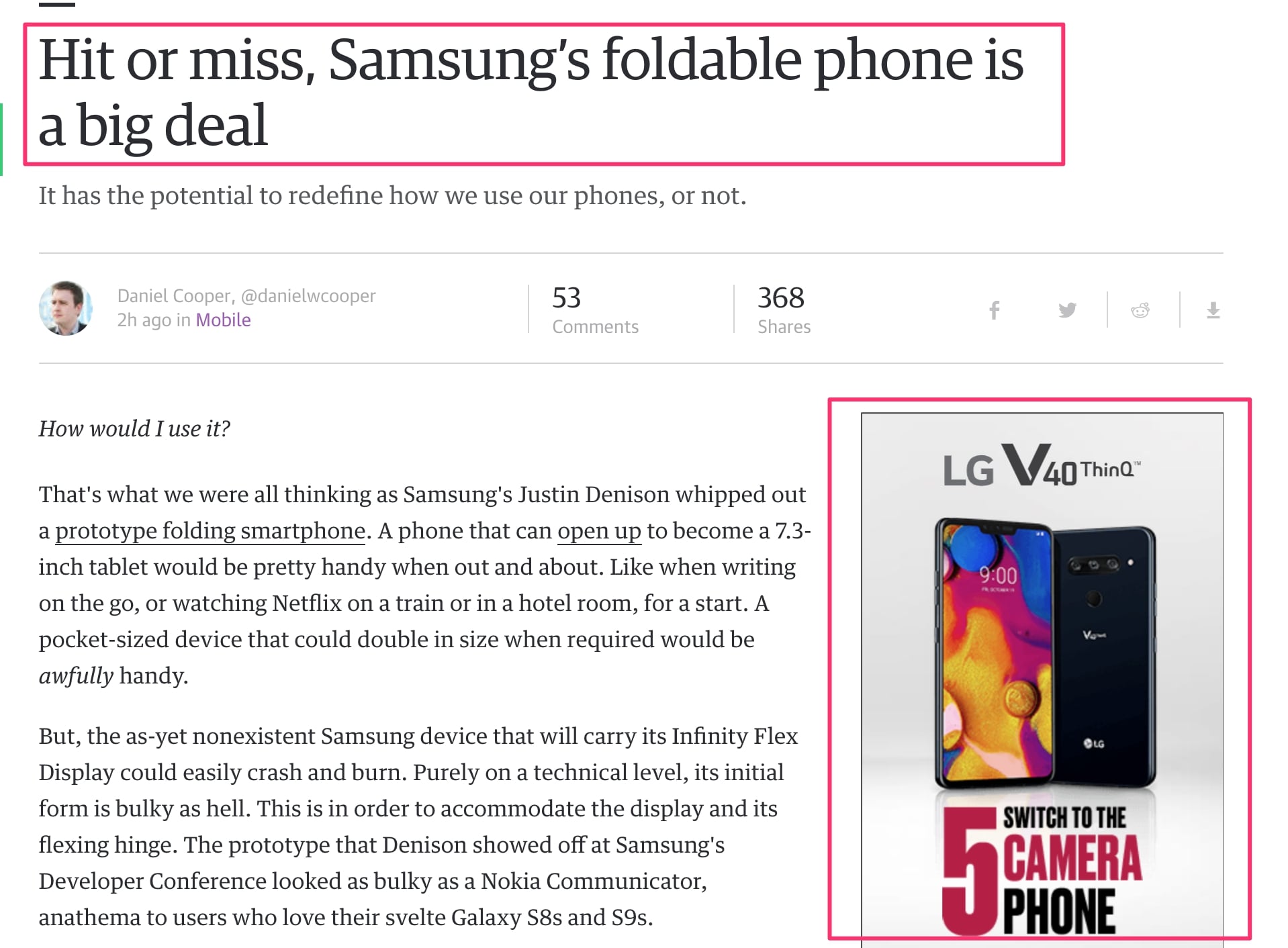
- Goal: Driving increased awareness around your product or service, and potentially driving sales, by displaying your ads on webpages in the Display Network that contain a specific theme based on a grouping of keywords.
- Relevance to audience: This will depend on the keyword themes you are targeting and how relevant the site topics/users are to your products and messaging.
- Estimated cost per click: Low (~$0.25 to $3.00).
- ROAS Expectations: Low (0:1 to 2:1).
- KPIs: Impressions, clicks, brand awareness, micro-conversions (email sign-ups, multiple page views, time on site, visiting your physical location if you have one), number of orders.
- Scalability: Generally pretty high, but it depends on the content keywords you’re targeting and the amount of content available for those keywords in the Google Display Network.
- Recommended for: Most brands could make the case that this should be one of the first upper-funnel campaigns to test, since you can get your product in front of users as they’re researching specific products or topics relevant to your brand. However, this type of campaign is not for brands that haven’t found success with other high-intent campaigns first, have a very low LTV, or have low interest in driving awareness or new customers.
Contextual display lets you get even more granular by serving your ads on webpages with content containing the specific keywords you’re targeting. You could use this campaign type to target content that contains certain branded keywords or keywords that pertain to your business.
The majority of a user’s time online is spent consuming and engaging with content, not searching on Google. Because of that, getting in front of users as they engage with content relevant to your product or service is always a potentially viable approach to test and measure lift. While not necessarily a priority over higher intent search campaigns, the ability to showcase your ads (image, text, video, etc.) to potential users without having to pay unless they click is a great opportunity.
Contextual campaigns are a great way to start on the Display Network because they let Google show you niche sites that might be available for you to directly target your audience on.
Note: You can get contextual campaigns and the Display Network as a part of your other search campaigns. However, we would always advise turning the Display Network off for search campaigns and turning search off for display campaigns. They work very differently, and so should be separated and budgeted as such to give you more control over how much money is spent on what effort.
Ease of implementation: Generally, if you understand how to group a few contextually relevant keywords and set up an ad through Google, you could start running this campaign. It’s not as hard as search ads, though there’s also no app or direct integration to automate set up.
9. Display ads (managed placement)
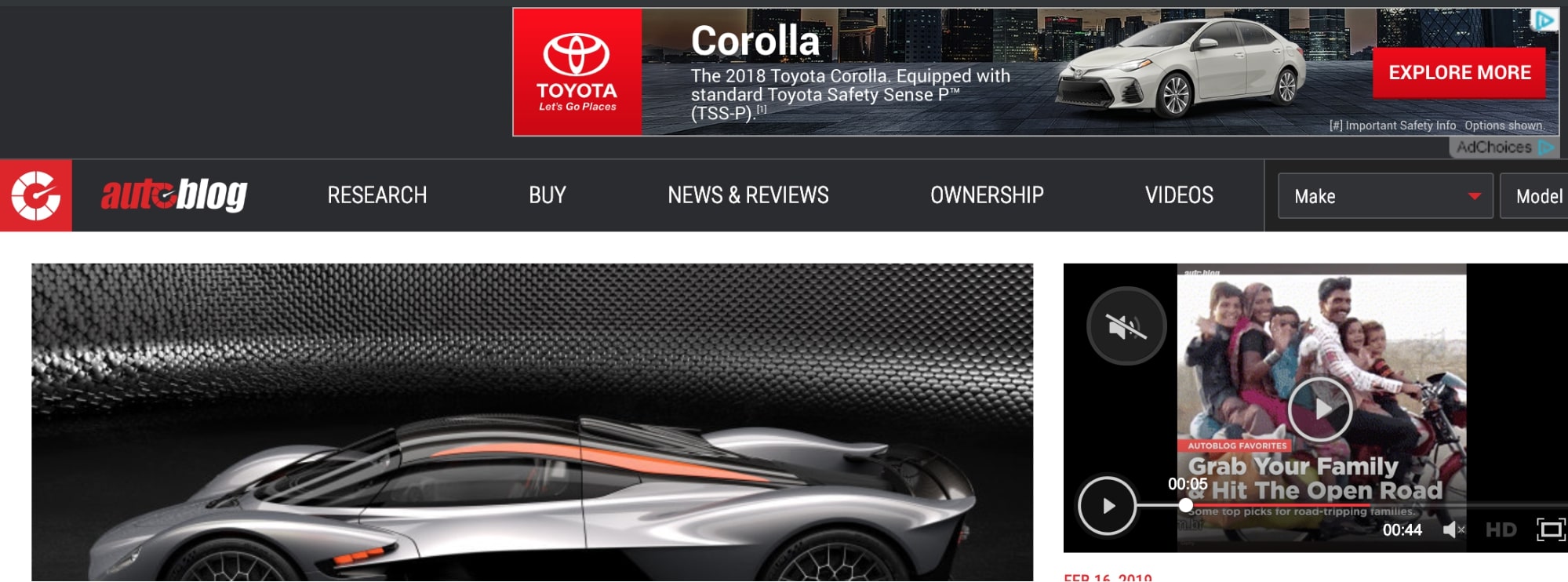
- Goal: Using ad space on a specific website to drive awareness about your product/service/business for that site’s specific audience.
- Relevance to audience: This will depend on the placement being chosen, how broad or specific the site’s topics/visitors are, and how well your product and messaging speaks to them.
- Estimated cost per click: Medium (~$1.00 to $10.00).
- ROAS Expectations: Low (0:1 to 2:1).
- KPIs: Impressions, traffic (increased brand awareness), orders, and micro-conversions (email sign-ups, multiple page views, time on site, visiting your physical location if you have one).
- Scalability: Generally lower but will depend on the site and its traffic (not all sites are targetable).
- Recommended for: Brands that want to get their product/service on a specific site to drive awareness after identifying the perfect site for their demographic and market.
Managed placements for Display Ads offer even more granular targeting and control than contextual, letting you select the specific websites, or even specific pages, you’d like to run your ad on in the Google Display Network. Outside of Google, you also can directly secure this type of advertising with websites, but for higher CPM rates.
Typically, you would execute this type of campaign after identifying the specific website placements that were effective in your contextual or topic/interest display campaigns.
Ease of implementation: Generally, this is an easier campaign to set up if you have some experience and can navigate around the Google Ads platform.
10. Google Smart Shopping
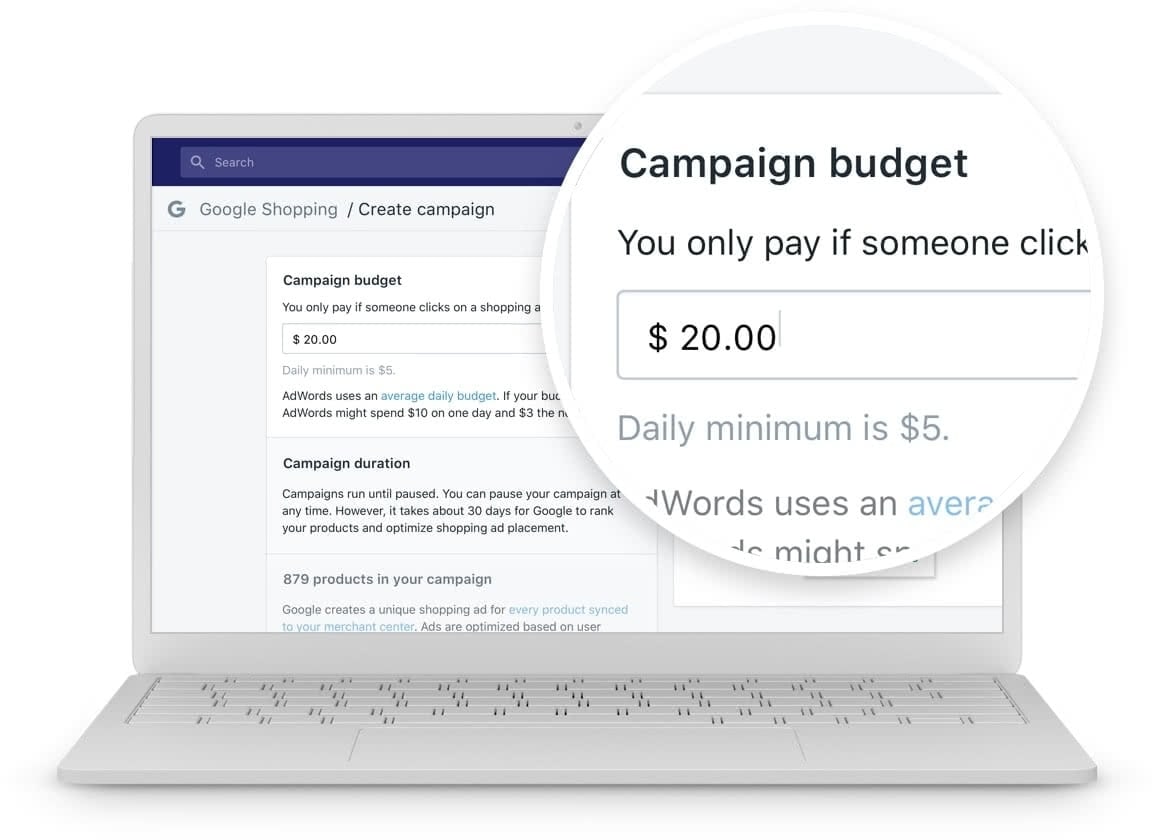
- Goal: Generating profitable orders through Google Shopping, remarketing, and display placements through machine learning.
- Relevance to audience: Varies, since it rolls multiple campaign types into one.
- Estimated cost per click: Low to medium (~$0.25 to $5.00).
- ROAS Expectations: Medium to High (0:1 to 12:1).
- KPIs: ROAS, orders, new customer acquisition.
- Scalability: Generally high, since non-branded traffic and display placements will be in your mix of traffic.
- Recommended for: Shopify merchants not currently using any retargeting and/or Google Shopping campaigns who want minimal involvement in managing them.
Google Smart Shopping campaigns use machine learning to optimize a mix of retargeting, display, and Shopping ads on your behalf.
This campaign type chooses which products to advertise, how much to bid, who to target, and which creative to show. Shopify’s integration with Google Shopping lets you pull your products and product feeds automatically into these campaigns—you can even launch directly from Shopify using Marketing in Shopify.
Your performance here will depend on how many users search for your brand, products, product categories, or branded keywords. The amount of retargeting you can do and the branded traffic you can drive through Shopping ads also depends on the search volume for your branded keywords and the size of your retargeting audience (i.e. how many people have visited your site already).
Ease of implementation: Smart Shopping represents a very easy way to get involved with Google advertising, whether with Shopping or retargeting ads. If you see success, there may be a greater opportunity to transition to a more segmented manual campaign strategy in the future.
Marketing in Shopify: Grow your business with Facebook and Google Ads

Marketing in Shopify is a new place to help you create, launch, and measure campaigns. We’ve streamlined the process to make running a successful Facebook carousel ad or Google Smart Shopping campaign easier than ever.
11. CRM (search, YouTube, Gmail)

- Goal: Generating repeat business or converting your subscribers into profitable orders by targeting customers who have already purchased from you or opted into your email list.
- Relevance to audience: Extremely high. (They’ve already given you their business or their information.)
- Estimated cost per click: Low ($0.25 to $5, depending on how aggressive you want to be with targeting.)
- ROAS Expectations: Extremely high (5:1 to 60:1).
- KPIs: ROAS, profitable orders, traffic.
- Scalability: Low, depending on the size of your customer base/email list and customer match rate (not every email you upload will be available to target in Google’s system).
- Recommended for: Any brand with more than 1,000 users in its email list and/or customer base.
Customer relationship management (CRM) campaigns are all about remarketing to your list of existing customers or subscribers.
This audience is highly qualified, so you can expect a great ROI if you execute your campaign properly. The one caveat is that you need to have an established customer base (i.e. thousands of emails), so this approach will not work for newer merchants.
These are hyper-targeted campaigns that leverage the information you have about your customers in your CRM. You can extend specific messaging to different segments of customers, targeting placements in Gmail, YouTube, or search.
About Customer Match Rate: Not every email you upload will match with Google’s database. For example, if you upload a list with 4,000 emails, Google may only be able to match 2,000 of them. Gmail addresses are more likely to have a match, but you can expect a sizable portion of your list won’t be targetable.
Ease of implementation: Not only do you need an established customer base to execute this campaign, you would also need the knowledge and experience to segment your list to speak to different customers differently If you have those elements, navigating Google Ads to upload your seed list and set up your ad types is pretty manageable and well-documented online.
12. Similar audiences

- Goal: Generating new customers and increasing awareness by advertising to users who have similar interests or characteristics to your existing customer base.
- Relevance to audience: This will depend on how similar your customers on your original list are and also how relevant your product/service is to the audience you’re trying to reach.
- Estimated cost per click: Low (~$0.25 to $3.00).
- ROAS Expectations: Low (0:1 to 2:1).
- KPIs: Clicks, impressions, traffic, orders, ROAS.
- Scalability: Generally large, depending on how many more users have similar interests. But since it will target all potential users on display, this campaign should have a high ceiling.
- Recommended for: Merchants who already have their most profitable campaigns set up and optimized and are looking to test new customer acquisition campaigns. A seed list of emails will need to be uploaded to Google to base your “similar audience” on.
Similar audience campaigns (like Facebook’s Lookalike Audiences) are based on the same remarketing lists we discussed with CRM. However, instead of advertising directly to your existing customers, this campaign will target similar users based on the data Google has about them.
Google Ads is able to take similar interests shared from your seed audience and match your ads to target other users on the Google Display Network who also share those interests..
Ease of implementation: We recommend trying intent-based campaigns first, but if you’re trying similar audiences on Facebook, this might also serve as a viable option to test and review performance.
13. Dynamic search ads
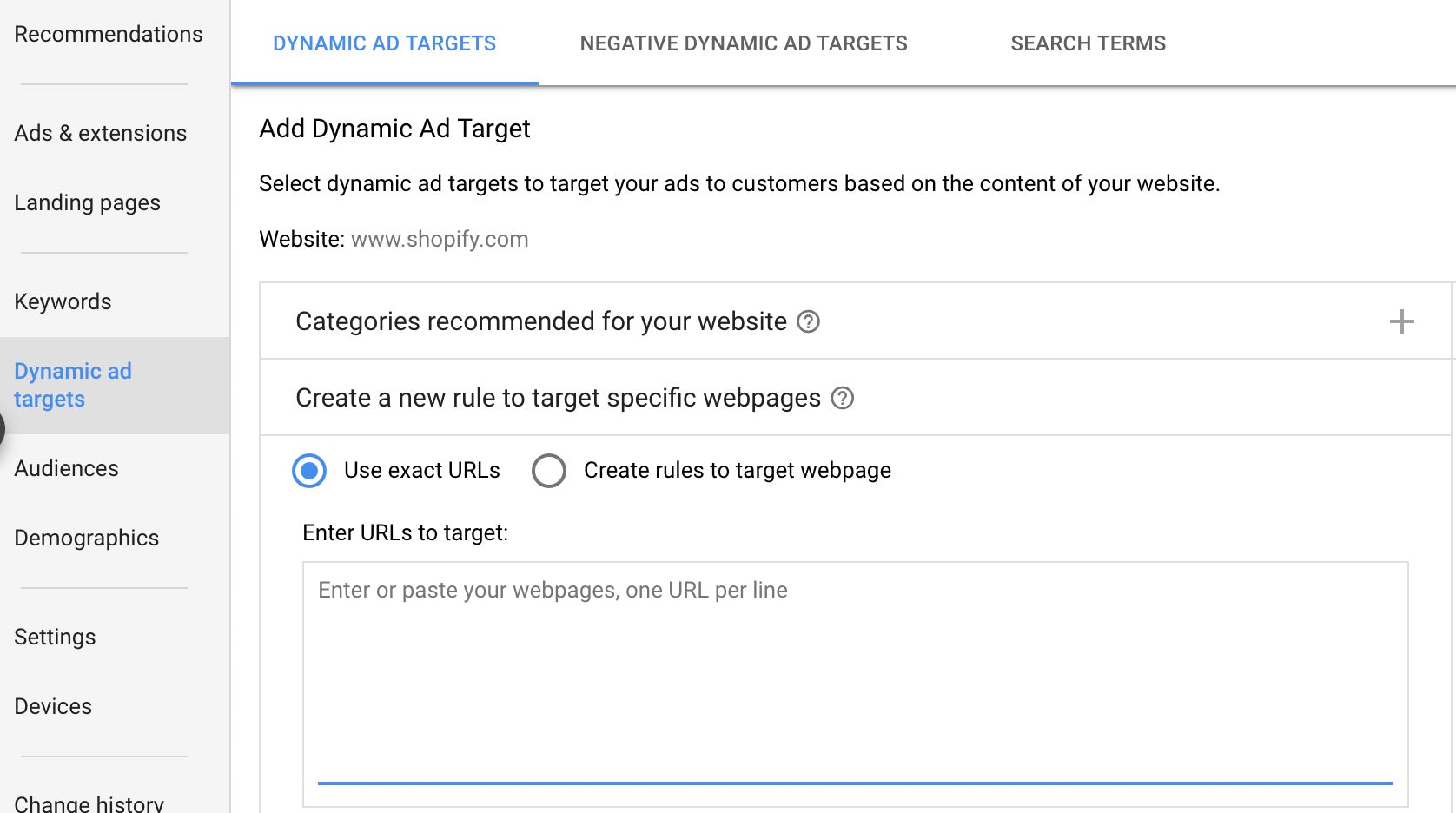
- Goal: Generating orders from search keywords automatically generated by Google.
- Relevance to audience: Low to high, depending on the keywords Google’s spider makes for your campaigns.
- Estimated cost per click: Low to medium (~$0.25 to $5).
- ROAS Expectations: Medium (0:1 to 12:1).
- KPIs: Orders, ROAS, traffic.
- Scalability: Generally high, since dynamic search ads will capture non-branded as well as branded traffic, but will depend on the type of keywords that are on your website for Google to crawl.
- Recommended for: Anyone who does not have the expertise to run a search campaign and wants to get something off the ground to see how it works, without making a larger investment.
Dynamic search campaigns essentially create search campaigns for all the different types of keywords they see on your site: branded keywords, non-branded category keywords, product-specific keywords, keywords from your descriptions, and maybe even event keywords from your About page or blog.
There’s no out of the box segmentation in this campaign so, like other campaigns that bundle together your traffic, we don’t recommend this as something to keep forever and scale but rather as a starting point to eventually segment manually as you gather performance data.
Ease of implementation: This is a great quick and easy way to get a search campaign online. However, while it’s easy to implement, there’s a large possibility dynamic search campaigns will contain irrelevant keywords that are on your site but that you would never manually buy to gain traffic.
Budgeting: always-on vs. testing campaigns
With any form of paid marketing, budgeting is an essential consideration that raises many questions. How should you set your budget? How long should you test a campaign/ad? How can you even tell if a campaign is achieving its intended purpose?
To answer these questions, you need to understand the two main categories of campaigns you’ll be running.
Always-on campaigns focus on profitability and high potential sales from shoppers who show intent to buy your brand/product/service. These are campaigns you’ll want to run continuously to capture your lowest hanging fruit. They include:
- Branded search
- Branded shopping
- Retargeting (especially visitors who abandoned their carts)
- CRM
- Niche campaigns that generate more sales, revenue, and higher profits than they cost
These campaigns generally are where you allocate as much budget as you can, starting with a daily spend you’re comfortable with and slowly increasing that amount if performance meets or exceeds your expectations (while maintaining your profitability).
For example, if you have only $10 a day to spend on marketing (or a fixed budget that you could spend 100% of), an always-on campaign might be the best use of that money—unless you have specific customer acquisition or awareness goals on which that money would be better spent.
Beyond converting your warmest audiences, you can also spend money to drive new customers to your site or drive awareness about your products/services to a specific audience.
That’s what testing/flexible campaigns focus on—driving new customer acquisition, awareness, and engagement with your site and products. They include:
- Non-branded search (niche)
- Non-branded search (competitor)
- Non-branded search (generic)
- Similar audience targeting
- Contextual campaigns
- Interest targeting
When setting a budget, always consider how a certain campaign’s goal aligns with your overall company goals, how well a campaign is doing in terms of meeting or exceeding expectations, and how much money you can actually afford to spend to achieve the goal.
If you’re managing your own Google ads, be mindful of your level of expertise with all of the above. You can get set up quickly with Google Smart Shopping or dynamic search campaigns to get you started, and then reassess what is best for your brand based on all the possible options and best practices explained above.
This always-on vs testing approach to budgeting can also be applied to other forms of paid marketing, from Facebook to influencer marketing campaigns, to decide how much budget to allocate and where.
How to hire help to manage your Google Ads
If you feel overwhelmed, you’re not alone. Many entrepreneurs who can’t afford the time or money it would take to successfully learn and manage their own Google advertising, outsource it to agencies or experts who specialize in paid advertising.
Here are some things to keep in mind when outsourcing your Google Ads:
- No long-term contracts: If it's not going well, you should be able to back out when you want.
- Ownership of all accounts, campaigns, and work: Everything should be fully transparent, and you should be the one to own the account, even if you aren’t managing it.
- Know your account manager: You ideally want to know and trust the person actually managing your account every day, rather than a salesperson or the CEO of an agency.
- Align on goals/expectations: You want a sense of what campaigns your agency wants to run, how it will budget, expected ROAS, and how long it’ll take to get it up and running.
- Understand the fee structure: Generally, you’ll either pay a flat fee or fees based on a percentage of your ad spend, with a minimum spend requirement. Be aware of how fees change as the spend changes and know that sometimes there can be additional setup charges. It’s a competitive space, so it doesn’t hurt to shop your business around to different providers.
- Consider specialized vendors: While it’s not impossible that the talented development shop that designed your website can also do your Google ads well, it often pays to work with more specific experts for the types of services or campaigns you’re going to run. There are pros and cons to working with a vendor that consolidates many outsourced services, so consider how much time you save from managing one vendor vs. the expertise and ROI you’re getting in each individual service.
If you’re looking to hire help, you can find Shopify Experts that specialize in search engine advertising specifically for Shopify merchants.
Final thoughts
We won’t sugarcoat it—succeeding with Google Ads isn’t easy. There’s a lot of nuance to each ad campaign type, with even more campaign types and variations that weren’t explicitly covered above, not to mention attribution, which is a key topic for another article.
But the Google Ads platform has benefits for any ecommerce business willing to figure out how to advertise to its massive user base based on search intent and a variety of other targeting options and placements.
Hopefully, you now have a better understanding of what’s possible on the Google Ads platform, what to expect from the different campaign types available, and how they can work together with the rest of your marketing engine.
Whether you invest the time and money into learning how to run your own campaigns, or lean on an agency's or expert's services, getting to know the platform and your options is a great first step in the right direction.
Was this content helpful to you? If you have any questions about Google Ads or digital marketing in a multi-screen world, let us know in the comments!
Illustration by Eugenia Mello